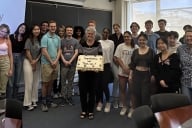You have /5 articles left.
Sign up for a free account or log in.
Especially in Western, Central New York and Pennsylvania, where President Obama is on a bus speaking tour of the region to give his opening salvos of a promised shake up of higher education, we await his pronouncements with bated breath. What could he possibly propose that we have not all thought about, discussed and implemented already as remedy to access, completion and tuition challenges? Prelude remarks bate our breath because word is out that at least some, perhaps most, of his proposals will be directed at our “industry!” (Never mind that as not-for-profit institutions in the main, with very different corporate foundations, we are not an “industry.”)
I feel a few defensive hairs rising on the back of my neck. Higher education has had a target on its back for some time now. We scramble to pull out the array of regulatory arrows that have already been thrown at us. Between FISMA and a variety of other legal and contractual regulations on the horizons, the research community is in an even higher gear at the moment on that point than the campus community overall. While I count myself as a long-standing advocate of accessibility, it did not escape my attention that organizations such as the National Federation for the Blind used higher education as the wedge to address accessibility issues for the big Internet guns, such as Amazon and Google. Last time I looked at P&L sheets, it is those guys and not higher education with all the money to hire lawyers and defend themselves, not to mention to pay the costs incurred to make applications accessible and perhaps provide templates on an open-source basis for us all to use to aid that goal. And do not get me started on the content industry and the “peer to peer” issue, although that conversation is far from over when raised to its proper subject heading, not of file share systems but of copyright, which incurs overwhelming costs for students and our colleges and universities in the publishing arena. Squeezing out their final dimes in the old model of print for expensive textbooks and with our old system of having for-profit companies sit as fat cats between research publication and traditional promotion and tenure of faculty tremendously burdens the costs of higher education that get translated into its price.
If I were on his policy team, here is how I would have him start this conversation:
“Over the last half century, health care and higher education costs have risen in tandem and about to the same degree. We have a debate in this country about how we should address health care expenses. Medicaid and Medicare we take for granted forgetting what tremendous social policy needs those programs addressed – care of the poor and elderly – those laws addressed when they came into existence in the 1960’s. More recently, we passed the Affordable Care Act. Not everyone agrees with that approach, but whether you agree or not with it, the main point I am trying to make about it in this context is that at least the country recognizes that access, minimum standards of care and affordability are public policy issues that require our attention as a fundamental policy challenge.
Before we start talking about any specific proposal for higher education, and whether it be geared at Congress or “the industry,” let’s make one basic shift in our thinking about the issue: it deserves the same degree of public policy attention that we have collectively given to the health care industry in this half century. Historically, the foundational legislation, the Higher Education Act, was passed in the same era as Medicare and Medicaid. But at the federal and state levels, we have not paid the same degree of careful attention to higher education as a public policy issue over the last century that we have devoted to health care. Nonetheless, it is as critical of a social need to the individual and as vital a societal responsibility as health care. If we value our children, our economy and the future of this country – including preserving the middle class, providing opportunity for upward mobility of all people, corporate innovation and the science and technology of national security -- it is an area that we must treat not by aiming arrow or creating scape goats, but by collectively discussing how as a country we will address access and accessibility, quality and completion, costs and price for the jewel in the crown of United States both at home and internationally.”
I’ll hand the pen over to his real writers to finish the speech. The quality of fairness shall not be strained; I will hold my fire and listen hard to what the President has to say. But I can predict that I will be disappointed if he frames the challenges we face as a political football or in any less comprehensive, thoughtful and socially responsible way.






